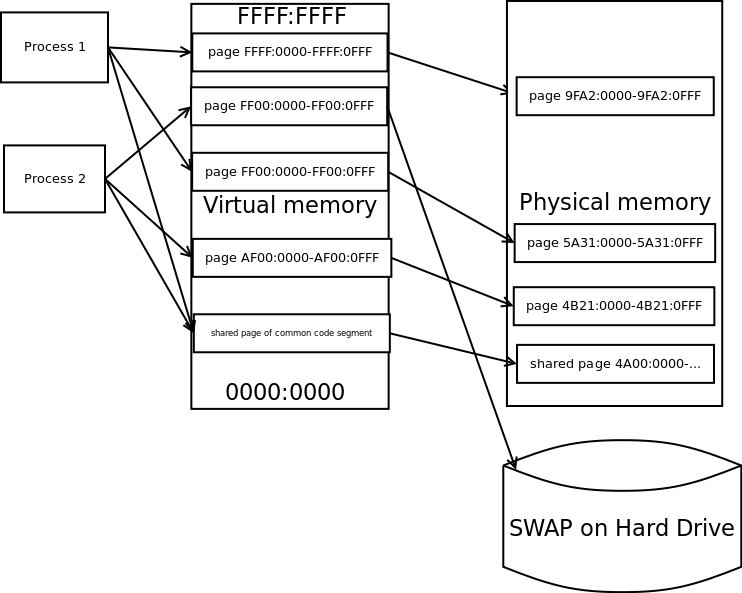06. Multitasking
(previous topic chore: how does cache strategies works anyway?)
- The task of multitasking
Effectively run a number of tasks over a certain time period
Rationale:
- Long-running I/O operations not using CPU vs. fast-running CPU mundane calculations
Slow human recognition (no difference between 1 ms and 1 µs)
Problems:
- Task alternation:
- timer interrupt
- context switch (registers, including PC and flags)
- Software vs. hardware
⇒ another task, the scheduler
- Task memory protection
- Software (any memory access wraps to grant subroutine)
- Hardware (tagged memory and code)
- Topological (address translation). E. g. forced indirect 24-bit addressing over special register with 32-bit address space (IBM PC i286).
- Overcommit
- Delayed memory provisioning (OS feature)
- Swapping/paging (OS + hardware)
Less evident problems:
- Cache inefficiency
- A number of hot areas
- Overall size
- ⇒ direct or associative?
⇒ both
 L1 and L2
L1 and L2 (also: different .text and.data caches)
Virtual memory
- Virtual memory
mapping single continuous 0…LIMIT memory of each process to the real physical memory. See Virtual memory
Features:
Usually hardware (see Translation_lookaside_buffer)
- ⇒ TLB needs caching too
Performed by pages (small page — large TLB, large page — more overhead)
- Better to be accessible only by kernel
CPU supervisor mode

Swapping
- Paging
keeping and (some/LRU/excessive) memory pages on disk and restoring it on demand
- Swapping
keeping (LRU/excessive) full process memory on disk
Problems:
- Overcommit (HDD is LARGE)
Spatial locality in charge

Hardware implementation: so called page faults
Multicore
Practical: it's easy to insert another CPU (and redesign system board), rather then develop a new processor, that is two times faster
But:
Parallel asynchronous memory access ⇒ Cache_coherence
- A set of problems: ordering, propagation, informing, bald devil, ...
- ⇒ L3 cache (L1/L2 are usually core-specific)
Too many cores: Non-uniform_memory_access
- …
Modern processors are all multi-core (many cores on one chip).
Virtualization
Practical: run a number of operating systems on one computer
⇒ run a number of isolated supervisor mode processes (usually OS kernels)
- ⇒ allow each kernel to manipulate it's own TLB
- ⇒ create 3-level hierarchy
- hypervisor mode (may be one of kernels or special hyperkernel) can create, run and manage
- kernels in supervisor mode
- subsequent processes
- Provide environment isolation
Hardware requirements
